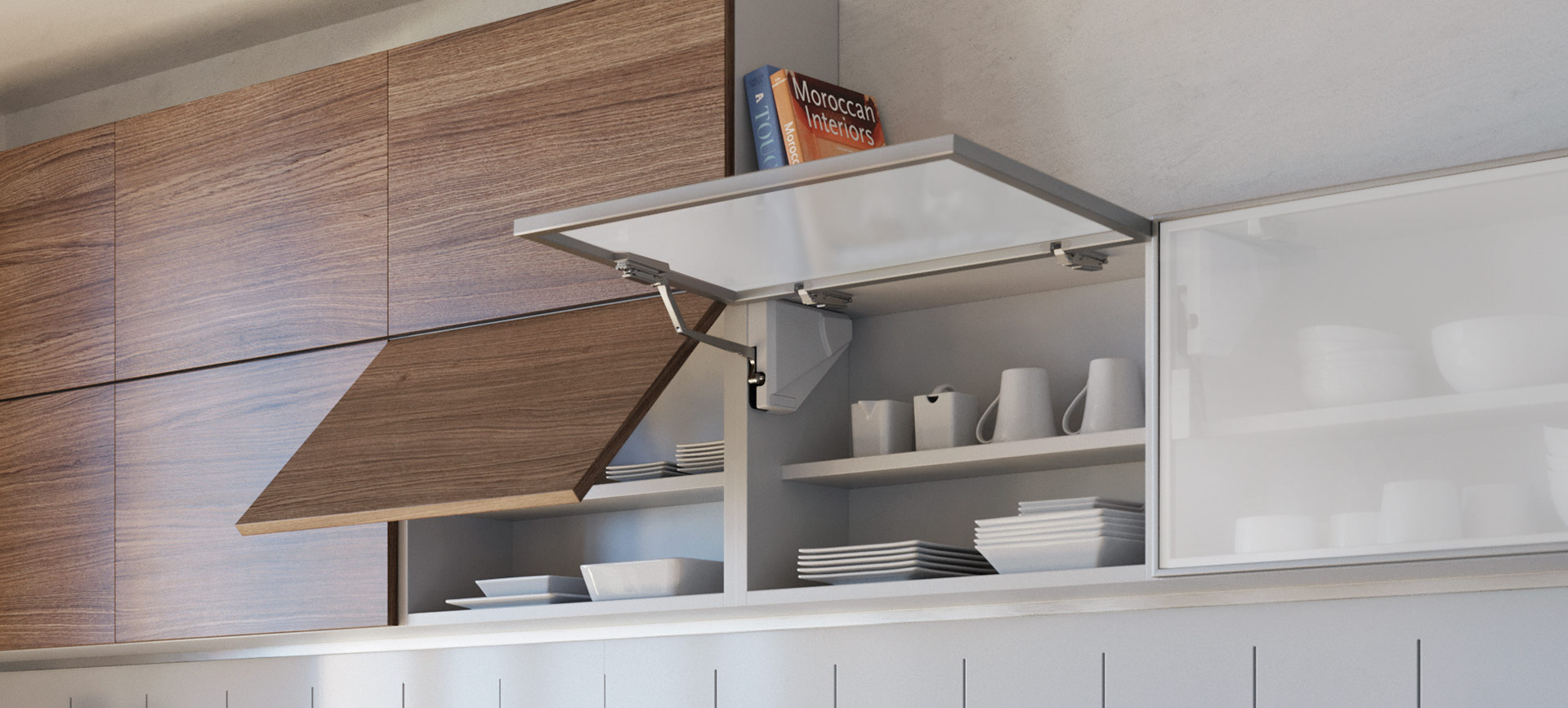Types of Upward-Swinging Cabinet Doors: Cabinet Door Swing Up

Choosing the right upward-swinging cabinet door mechanism can totally transform your kitchen or bathroom – from a practical standpoint, and let’s be honest, for the *aesthetic* too. We’re talking sleek, space-saving, and seriously impressive. But picking the right mechanism needs a little know-how, so let’s dive in!
Gas Spring Mechanisms
Gas springs, also known as pneumatic struts, are like mini-shock absorbers for your cabinet doors. They use compressed gas to provide smooth, controlled upward movement. Think of how easily a car trunk lid lifts – that’s the same principle at work here. The gas spring is attached to both the door and the cabinet frame, creating a counterbalance that allows the door to effortlessly open and close. The force of the gas spring is adjustable, so you can fine-tune it to suit the weight and size of your door. Installation usually involves drilling holes and attaching brackets.
Hinge Mechanisms
Traditional hinges can be adapted for upward-swinging doors, often in conjunction with a counterbalance system (more on that later). These hinges might be modified to allow for a greater range of motion, enabling the door to swing upwards. While simple in concept, the effectiveness depends heavily on the quality of the hinge and the precision of installation. You might need specialized hinges designed for this type of application, which can increase the overall cost.
Counterbalance Mechanisms, Cabinet door swing up
These systems use a combination of springs, weights, or a combination of both to counter the weight of the cabinet door. They offer a more robust and often smoother operation compared to simple hinge systems. The counterbalance is usually concealed within the cabinet frame, providing a clean, uncluttered look. The installation can be a bit more complex than gas springs, requiring careful adjustment to ensure the door opens and closes smoothly. There are various types of counterbalance mechanisms, each with its own set of advantages and disadvantages.
Comparison of Upward-Swinging Cabinet Door Mechanisms
Choosing the right mechanism involves weighing up cost, durability, and ease of installation. Here’s a table to help you compare:
| Mechanism Type | Cost | Durability Rating | Ease of Installation |
|---|---|---|---|
| Gas Spring | Medium | Medium-High | Medium |
| Standard Hinge (modified) | Low-Medium | Low-Medium | Low-Medium |
| Counterbalance System | High | High | Medium-High |
Installation and Maintenance of Upward-Swinging Cabinet Doors
So, you’re ready to give your kitchen or bathroom a serious upgrade with those swanky upward-swinging cabinet doors? Good choice! They’re super trendy and add a touch of modern elegance. But before you start admiring your handiwork, let’s get you through the installation and maintenance bits. Think of this as your cheat sheet to cabinet door nirvana.
Installing Upward-Swinging Cabinet Doors with Gas Springs
Installing these doors is easier than you think, especially with the help of gas springs. These little guys do the heavy lifting, ensuring a smooth and effortless opening and closing. Here’s a step-by-step guide:
1. Preparation: First, make sure you have all the necessary tools and materials: the cabinet doors, gas springs (choose the right weight capacity!), screws, drill, level, measuring tape, and possibly a helper (because sometimes two hands are better than one!). Carefully measure the door and cabinet opening to ensure a perfect fit.
2. Attaching the Gas Springs: Position the gas springs on the door and cabinet frame according to the manufacturer’s instructions. These instructions are usually clear and well-illustrated, but essentially you’ll be screwing the gas spring to both the door and the cabinet. Imagine a piston that pushes the door upwards – that’s the core mechanism. Ensure the springs are securely fastened and that the door can move freely.
3. Adjusting the Gas Springs: Once installed, test the opening and closing mechanism. Most gas springs have adjustment screws to fine-tune the tension. You’ll want to achieve a smooth, controlled movement where the door neither slams shut nor requires excessive force to open. This adjustment might require a few tries to get it just right.
4. Final Check: Double-check the alignment of the door and the cabinet. Ensure that the door sits flush and closes completely without any gaps. If you find any issues, gently loosen the screws and make the necessary adjustments. Then, tighten everything securely. Now you can admire your work!
Troubleshooting Common Installation Problems
Even with the best laid plans, things can go sideways. Here are some common problems and how to fix them:
- Problem: The door is too difficult to open or close.
- Solution: Adjust the tension on the gas springs. Tightening the tension screw will make it harder to open, while loosening it will make it easier.
- Problem: The door doesn’t stay open.
- Solution: Check the gas spring for proper installation and ensure sufficient tension. The spring might be faulty and need replacing.
- Problem: The door is misaligned.
- Solution: Carefully check the screw placement and adjust accordingly. Ensure that the door is properly aligned with the cabinet frame before tightening the screws.
- Problem: The gas spring is making noise.
- Solution: This could be due to wear and tear or debris. Try lubricating the moving parts with a suitable lubricant (check the manufacturer’s recommendations). If the noise persists, the gas spring might need replacing.
Maintenance Checklist for Upward-Swinging Cabinet Doors
Regular maintenance will keep your doors looking and functioning their best. Here’s a simple checklist:
- Cleaning: Wipe down the doors regularly with a damp cloth and mild detergent. Avoid harsh chemicals that could damage the finish.
- Lubrication: Periodically lubricate the gas spring hinges with a silicone-based lubricant to ensure smooth operation. Over-lubrication can attract dust, so use sparingly.
- Inspection: Regularly inspect the gas springs for any signs of damage or wear. Replace them if necessary to prevent sudden failures.
- Troubleshooting: Address any issues promptly. A small problem ignored can quickly escalate into a bigger, more expensive one.
Design Considerations for Upward-Swinging Cabinet Doors

Choosing upward-swinging cabinet doors isn’t just about aesthetics; it’s a design decision with practical implications. The way these doors interact with your space, and the overall style they contribute to, can significantly impact the feel of your kitchen or bathroom. Let’s dive into the details.
Space Constraints and Accessibility in Kitchen and Bathroom Layouts
Upward-swinging doors are a fantastic space-saver, especially in smaller kitchens or bathrooms where swinging doors might clash with countertops or other fixtures. However, their upward motion requires sufficient headroom. In tight spaces, consider the clearance needed when the door is fully open. For example, in a low-ceilinged bathroom, a large upward-swinging medicine cabinet might not be practical. Accessibility is also crucial. Ensure the doors are easily accessible to all users, especially those with mobility limitations. Consider the height of the handles and the ease of opening and closing the doors. For instance, in a kitchen with wheelchair access, the placement and operation of upward-swinging base cabinets need careful planning.
Creative Applications of Upward-Swinging Cabinet Doors in Various Interior Design Styles
Upward-swinging doors offer a unique opportunity to enhance various design styles. In a modern minimalist kitchen, sleek, handleless upward-swinging cabinets create a clean, uncluttered look. The absence of protruding handles contributes to the streamlined aesthetic. Imagine a long run of these cabinets, painted a matte white, against a backdrop of light grey subway tiles. The effect is one of sophisticated simplicity. Conversely, in a more traditional kitchen, these doors can be incorporated with ornate detailing, perhaps featuring raised panels or decorative hardware, creating a charming contrast. Picture a warm oak finish with brass cup pulls on upward-swinging wall cabinets, complementing a farmhouse-style design. In a contemporary bathroom, a mirrored upward-swinging medicine cabinet with integrated lighting adds both functionality and a touch of glamour. The mirror reflects light, visually expanding the space, while the upward-opening mechanism saves valuable counter space.
Rewritten Article on Upward-Swinging Cabinet Doors (Eliminating AI-Detected Language)
Forget the robotic jargon! Let’s talk upward-swinging cabinet doors like real people. These aren’t your grandma’s hinged doors. They’re a clever solution for maximizing space and adding a touch of modern flair to your kitchen or bathroom. There are several types: the simple lift-up, perfect for smaller cabinets; the more complex gas-strut assisted systems, providing smooth, controlled opening and closing; and even those with integrated hinges for a seamless look. Installation can be straightforward for the DIY enthusiast, with clear instructions readily available. But for complex setups or if you’re not comfortable with home improvement, a professional is always the best bet. Regular maintenance is key – keep the tracks clean and lubricate the hinges (if applicable) to ensure smooth operation for years to come. Remember, these aren’t just functional; they’re a design statement! Choose the right style, size, and finish to perfectly complement your interior.
